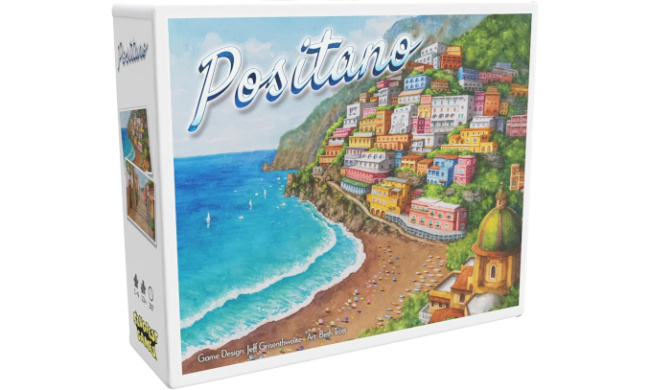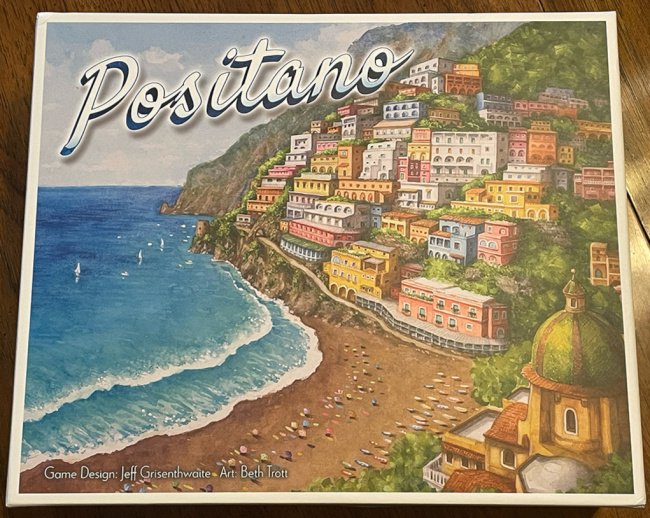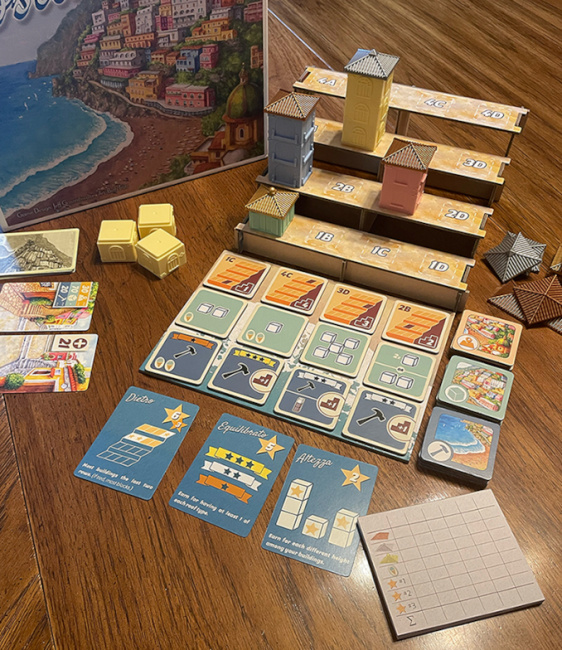Positano
Publisher: Slugfest Games
Release Date: June 2025
MSRP: $49.95
Designer: Jeff Grisenthwaite
Artist: Beth Trott
Number of Players: 1 to 4
Playing Time: 30 min.
Product #: SFT091
Age Rating: 13 and up
ICv2 Rating: 4 Stars out of 5
There is a long tradition of games named for picturesque European towns, providing a theme hung loosely on the game mechanics. Sometimes, the theme fits nicely, as it does with Positano, a bidding game about building pastel houses on the cliff-face of a seaside town. But does the game stand up or crumble into the sea?
Summary: In Positano, players bid for the right to construct tower-like buildings in the four tiers of the town using identical hands of bidding cards. Bids also determine how many floors they can build and the "quality" of their construction, indicated by bronze, silver, and gold roofs. At the end of the game, building floors score based on their quality, but only if they can "see" the beach—in other words, if they are taller than the buildings in front of them. Along the way, the players strive to complete three shared objectives and collect “gelato,” which appears on the weakest cards and tiles, for more points. As tradition demands, the player with the most points at game end claims victory.
The resource tiles available are placed in three rows on the "beach" in front of the city, then all players secretly choose a bid using two cards: a base bid and an additive card. The base bid cards show different bids for each type of tile: building location, building floors, and building quality, with some offering bonus actions or gelato points. The additive card is applied to all three bids, which are then ranked with the highest bids getting first choice in that category. As the bids are resolved, the players get to place one building each round, obeying the "height restrictions" for the part of the city they are allowed to build in, unless a tile allows them a variance to build higher.
Originality: There is a lot in Positano that will immediately feel familiar. The building locations follow a very Acquire-esque grid. Bidding using an identical hand of cards has appeared in too many games to count. Earning points for building houses is a common mechanic. But this game approaches these familiar themes in an innovative and interesting way to provide surprising depth. The fact that the bidding cards have different bids for the three types of tiles, all of which are important every round, forces players to balance their plan carefully. The multi-tiered board creates four districts with different construction limits and scoring opportunities, and the ability to block opponents from scoring by building in front of them forces strategic as well as tactical planning.
Presentation: Beth Trott’s artwork captures the charm of the namesake Italian town, with soft lines and pastel colors inspired by the source. The box is hefty, hinting at the amount of materials inside. The box back has a splendid photo that shows off the components nicely, and a brief but informative description that captures the core elements of the design. The font used for the title is a bit hard to read, unfortunately, particularly at a distance, and the soft color palette combined with the white background does look a little washed out, but overall the presentation is tasteful and pleasant.
Quality: Inside the box, things get even better. The rulebook has bright, friendly colors and easy-to-read instructions with generous illustrations and examples, though a couple spots could have been a little clearer as I had to read them more than once. The building blocks are splendid and robust, crafted from good quality, sturdy plastic. They stack perfectly if a bit tightly, as do the shiny metallic-colored roofs. The tiles are extra-thick, gameboard-weight, as is the four-level game board. The cards are good quality with a nice gloss finish. The artwork is consistently good throughout and captures the setting nicely. I did have one significant disappointment, however: Despite the box being quite deep, it is not deep enough to store the game board once it is assembled, forcing one to dismantle it when putting the game away. I worry that repeated assembly and disassembly will wear on those pieces, and the game experience would really suffer without the three-dimensional board.
Marketability: Positano falls squarely in the "Euro" category, and offers a lot to appeal to fans of that type of game. The simple rules and emergent gameplay has features for both casual players and fans of mid-weight strategy games. The short playing time, quick pace, and non-confrontational style of competition makes it suitable for families and "friendly" gamers. The price tag is a bit daunting, but the heft of the box, the quality of the components, and the replayability thanks to the random goal cards goes a long way to justify the cost.
Overall: I am not, in general, a fan of bidding/auction games. But the mechanisms of Positano minimize the features of the genre that I dislike and the puzzle-like challenge of using a single card to bid for three things at once create a playing experience that I quite enjoyed. And others in my group who are big fans of bidding games had as good a time playing as I did. The playing time and pacing of the game means that it is unlikely to wear out its welcome even after a number of plays. The included solo variant offers a compelling challenge that requires careful balance and forethought to find success.
There are a few missteps, such as the aforementioned box size issue, but none of these are severe or detract from the enjoyment of the game. It is a bit pricy for a light- to middle-weight Euro-style strategy game, which may make some reluctant to pick it up. I think that would be a shame, as Positano is a pleasant, semi-casual bidding game with appeal both to fans and non-fans of that genre that takes familiar tropes of game design and turns them on their head in interesting ways. That’s why I’m giving this game 4 out of 5.

ICv2 Stars: 4 (out of 5)
Posted by William Niebling on July 11, 2025 @ 4:32 am CT




